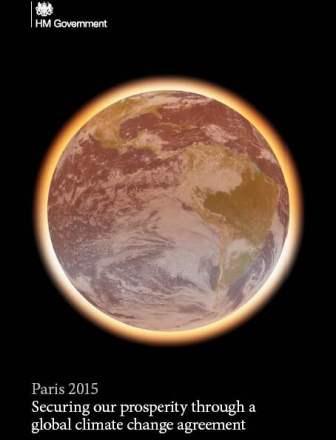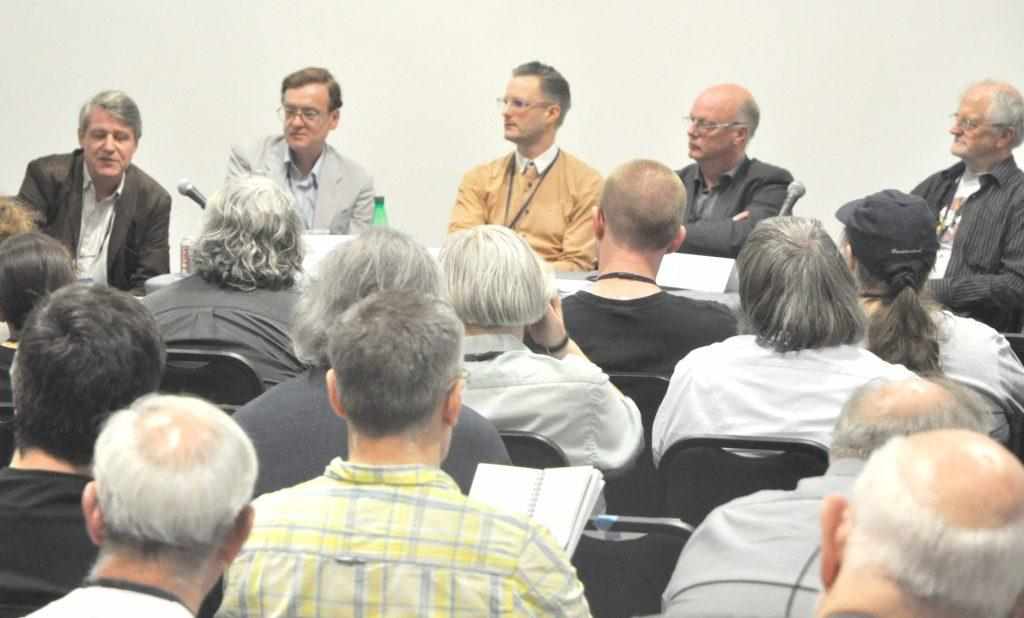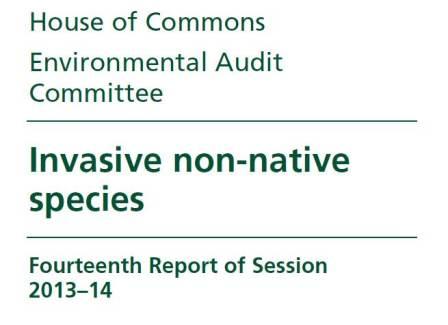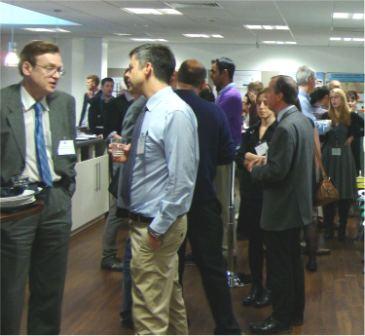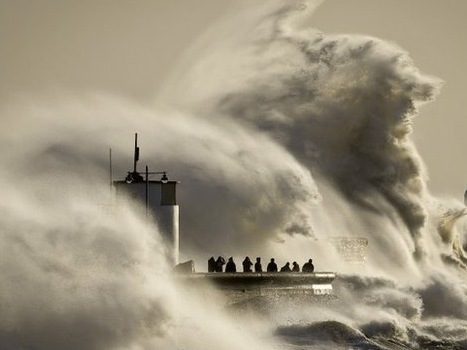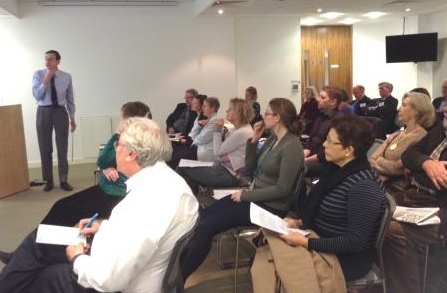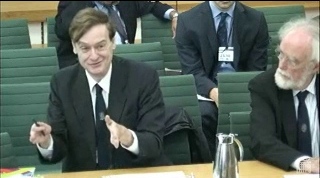|
.
.
.
.
.
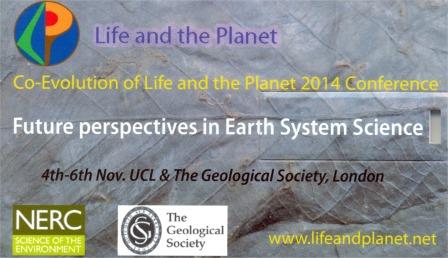
.
 Clouds - An example of climate feedback.
Clouds - An example of climate feedback. |
.
Concatenation Science Communication
Past news 2013/14
.
Autumn 2014 More continuing professional development (CPD) attending a couple of symposia. (For those from
a more biomedical background, CPD is analogous to clinicians' CME or continuing medical education.) Both events were two-day gatherings. First up: a symposium
at the geological society which was a follow-up to the NERC 'Co-evolution of Life and Planet' research programme and its associated 2011 symposium. Once again it was held at the Geological Society (so enabling use of the Fellows Room
and its cybercafé in the lunch breaks). The event was not just interesting but useful for a project I am currently working on. The second, held
in the run up to Christmas, was a Royal Society 'Discussion Meeting' on Climate Feedbacks. These are factors that, in addition to greenhouse gas warming, further affect climate change
in either a warming or cooling way. For example, clouds form a climate feedback. As the Earth warms there is more ocean evaporation and this results in
more clouds which then reflect more energy back out into space and so cool. (There are, of course, other cloud-related climate feedbacks and indeed many other feedback mechanisms. I myself am particularly interested in long-term feedbacks, such as warming oceans reaching a point where the clathrate layer gets disrupted releasing methane causing further warming). Anyway, both events featured much of interest.
|
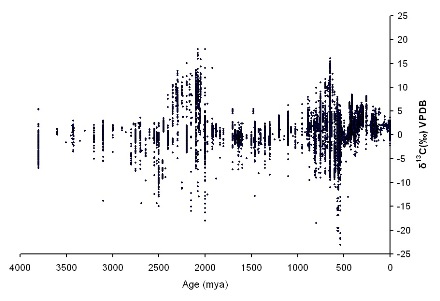 Some 12,000 data points chart the
Some 12,000 data points chart the
strength of the Earth's photosynthetic
pump over 4 billion years. A very boring
task but illuminating. Much thanks to
those who originally compiled the data
from the literature and for putting it online:
Veizer, J., D. et al (1999) and Sheilds, G.,
et al (2002). |
Autumn 2014 What has been the strength of the Earth's photosynthetic pump over the past four billion years? I have just spent arguably the most boring three weeks of my life devoting my writing time to plotting the carbon-13 to carbon-12 ratio graph from geological strata going back nearly four billion years. You see, the majority of carbon is in the form of carbon-12 (12C) and a only a tiny minority is 13C. The thing is that photosynthesis preferentially prefers 12C over 13C. This means that when the Earth's biosphere is doing a lot of photosynthesis more 13C is left in the atmosphere and dissolved in water as carbonate (the stuff that furs your kettle). So looking at the geological record of the 13C:12C ratio is an indication of the biosphere's photosynthetic pump on one hand and also reverse episodes such as the volcanic combustion of organic (coal and tar sands) strata on the other. (And background plate tectonic recycling through volcanic venting continually re-sets the value over the long-term.)
|
|
The reason this was a boring three weeks was because there were some 12,000 data points to plot! (It made other mundane tasks these weeks positively exciting.) You can't see all of these points on the graph above because duplicate readings by many scientists cause hundreds of the points to fall on top of one another in a vertical stack rising out of the graph.) And the importance of the graph? It shows two periods 650 million years ago to 750 mya and 2,050 to 2,300 mya of rapid oscillating high and low carbon cycling that coincide with the rise of multi-celled plants and animals, and the evolution of eukaryotic cells from simple bacterial type (prokaryotic) cells respectively. This work is for a venture that will hopefully be completed next year. And, yes, I could have put in a copyright request but I do like to get to grips with the data from primary research wherever possible and plot my own graphs as it enables one to see exactly what is going on and appreciate strengths and limitations of the data.
|
|
.
.
2°C or not 2°C?
.
Further science support for the
conclusions to my 2009 essay
Can we
beat the climate crunch?
|
Autumn 2014 Can we beat the climate crunch? Further support for the conclusions to my 2009 essay that while a 2°C limit to warming might be considered 'safe', it is a warming limit to which we cannot adhere and so is, in policy terms, meaningless. A comment article in the journal Nature calls to ditch
the 2ºC warming limit goal. "Politically and scientifically, the 2°C goal is wrong-headed. Politically, it has allowed some
governments to pretend that they are taking serious action to mitigate global warming, when in reality they have achieved
almost nothing. Scientifically, there are better ways to measure the stress that humans are placing on the climate system
than the growth of average global surface temperature — which has stalled since 1998..."
|
|
|
And: "Because it sounds firm
and concerns future warming, the 2°C target has allowed politicians to pretend that they are organizing for action when, in
fact, most have done little. Pretending that they are chasing this unattainable goal has also allowed governments to ignore
the need for massive adaptation to climate change." (David G. Victor & Charles F. Kennel (2014) Ditch the 2°C warming
goal, Nature 514, 30-31.) This chimes with a Nature editorial in the same issue: "The
politics and the science of climate change have long since parted company..." And: "The science, of course, can help to
guide policy, as is explained in a Comment on page 30 on the absurdity of the 2°C target for global temperature rise..."
(Nature (2014) 'Warming up', vol. 514, p5-6.)
This builds on previous science and comment to Can we beat the climate crunch?
conclusions. The Nature comment article is cited at the essay's end along with other papers/publications subsequently published to Can we beat the climate crunch? (2009) and that chime with its conclusions.
.
|
|
|
Autumn 2014 Great Britain & NI publishes a position statement in advance of Paris 2015. Published by the UK Department of Energy and Climate Change (DECC), well in advance of the Paris Conference of Parties (COP to the UN Framework Convention on Climate Change) meeting, the UK statement summarises its message in its title Paris 2015: Securing our prosperity through a global climate change agreement. This is a message I first seriously tried to promulgate back in 1998 with Climate and Human Change: Disaster or Opportunity and subsequently by those far better than I (such as the UK Treasury commissioned 'Stern report' in 2006).
The 2009 Copenhagen COP saw over 90 countries, covering 80% of global emissions, have pledged to cut their emissions by 2020 under the Copenhagen Accord. However, as the UK's Paris 2015 notes we are now playing catch-up. By 2020, global emissions will be well above the cost-effective pathway to 2°C and will only grow without action to tackle them. Now the problem -- and it is something I did not really emphasis back in 1998 (I was really focussing on the evidence for climate change as climate scepticism/denial was far more rampant then that now but saying that even hypothetically there was no human-induced climate change that greenhouse policies conferred a raft of other benefits that made much medium-to-long-term sense) -- is essentially a Hardin 'Tragedy of the Commons' thing in that while some nations may curb emissions others may not (in other words cheat) and so gain short-to-medium term economic advantage over those that do curb emissions. To get around this all nations need to agree to common regulation (regulation being the solution to Hardin's tragedy). This is essentially what the UK's Paris 2015 document calls for (which they do remarkably without mention of Hardin (and unremarkably Climate and Human Change: Disaster or Opportunity; I am for too low down the food chain for that)). Will the UK's very commendable call be heeded? I hope so, but sadly, realistically, doubt it. The report came out just prior to the 2014 New York COP meeting (from which at the moment it looks like India, China, Australia and Germany will be absent) and which in turn will prepare the ground for the 2015 Paris COP.
|
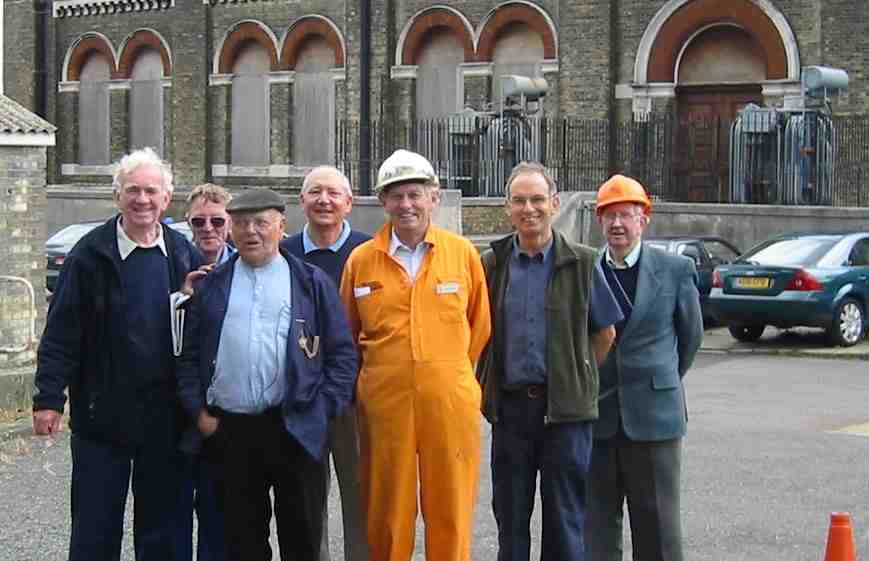 Fred Dibnah at Crossness a few years ago. Fred Dibnah at Crossness a few years ago.
It was his last visit as part of his BBC TV
show. He is with members of the
Crossness restoration team. |
Autumn 2014 Cutting back on Crossness. I have barely mentioned on this site the work I have done the past nine years for the Crossness
Engines Trust. Crossness is one of the two Victorian pumping houses at the end of the sewage system built by the Victorians to address the 'Great Stink'. It is the second most important industrial heritage site in SE London (the most important being Tower Bridge), and has attracted much interest from those into industrial and engineering heritage, including by the likes of the late Fred Dibnah. For the most part I have been providing a basic press service but now, as this is now going in-house, I am bowing out. Still, nine years is a reasonable stint. In addition to press work,
I have undertaken a few other ventures for the Trust: one, on Science for Heritage even drew upon my Parliamentary science liaison experience. I still have one outstanding project for Crossness -- more news of which hopefully next year -- but as it is close to contract I would have been (hence will be) handing this over to Crossness shortly anyway.
|
 This year's World SF Convention,
This year's World SF Convention,
Loncon3, was in Britain.People pictures at Worldcon below by
Roberto Quaglia and Peter Tyers.
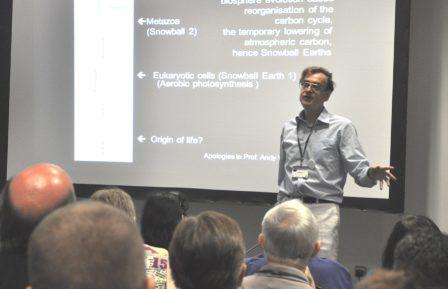 'Climate catastrophes: Past as a guide to the future.'
(Shhh. Don't tell anyone...
'Climate catastrophes: Past as a guide to the future.'
(Shhh. Don't tell anyone...
It's really co-evolution of life and planet.)
Also below...

 'The bugs are coming back.' A panel on antibiotic resistance. (From left: Jonathan, Perriane Lurie, Sarita Robinson, John Cmar.)
'The bugs are coming back.' A panel on antibiotic resistance. (From left: Jonathan, Perriane Lurie, Sarita Robinson, John Cmar.) Lativian publisher Imants Belogrîvs and
Lativian publisher Imants Belogrîvs and
Jonathan. The Worldcon saw much
networking, establishing contacts
and renewing old acquantances.
 Jonathan and Iain at the 1993 Eurocon,
Jonathan and Iain at the 1993 Eurocon,
Jersey, Great Britain.
 Nearly a decade on and still selling well.
Nearly a decade on and still selling well.
|
Summer 2014 Genre professionals, buffs and aficionados gather for 72nd World Science Fiction Convention (Worldcon), Loncon 3.
And for the first time in over half a century it was held in London! Just three days in and attendance was over 7,000 with more than over 3,000 additional non-attending registrants (who registered just for the publications and Hugo Award voting rights). Authors, editors and agents did their thing for five days. Fans got to spend
time with their literary idols, and then there were the scientists and an opportunity for public engagement. It may seem a little odd for science and scientists
to have profile at such an event, but remember that among the genre's social impact is that SF fosters enthusiasm for science
fact; indeed surveys show that a number of scientists were turned on to their career by SF, and of course we are always being cajoled by research funders and policy-makers to engage in public outreach. And so in addition to an 'academic' (in this case an arts approach to the genre), an art (visual), comics, costume, film, literature, media, music and gaming programme tracks, there was also one for science, and all these tracks took place within roughly 18 parallel streams of programming. Indeed, there was so much science that quite often there was more than one science item on at the same time. Scientists present ranged from the likes of Lewis Dartnell (with whom I have previously worked) and Ian Stewart, to heavyweights such as David Southwood and Martin Rees FRS: indeed Martin always says (and did again at this event) that 'it is better to read first class science fiction than second class science'. Now, I had hoped that Loncon 3 would see Jack Cohen CBiol FIBiol and I do a duologue. (Jack was a prominent member of the Institute of Biology where I worked for many years, and previously both of us have given many solo science talks at SF conventions as well as being together on panel discussions.) Sadly circumstances were such that that was not to be (Jack was unable to attend) and, as the next British Worldcon will be around a decade from now, it seems as if such a duologue will now never again happen.
My own solo talk at Loncon was on in the morning of the first day on climate catastrophes past and future. Actually this was not so much an IPCC palaeoclimate perspective (though that was included) but more an Earth systems science 'co-evolution of life and planet' thing; I felt this was a little more exotic and appealing to SF fan tastes, not to mention timely as a NERC research programme on that topic has just concluded. Sadly, such was the prominence of science on the programme that I was up against three other science items at the same time. Also, my talk being early in the morning of the first day meant that less than half of the event's attendees had yet to arrive and register. Nonetheless, my room was full, and by my talk's end it was standing-room
only at the back and down the aisles. Now, don't get the idea that this was solely due to my (ahem) popularity, it was as much due to the London ExCel's poor conference centre design: the centre's main hall can hold 5,000 but the centre's breakout rooms for specialist programming collectively only hold around half that. (But don't be too hard on the Excel: Britain as a whole does not have any good 'conference' centre despite the CSTI (the Science Council's precursor body) lobbying for one in the 1980s and '90s: all the UK has are good 'exhibition' centres, and they are quite different beasts.) By the first day's afternoon, the majority of the attendees had arrived and registered, so over-crowding in the specialist programme rooms became a chronic problem for all but the least appealing (or perhaps most specialist) programme items and Excel staff instigated patrols enforcing fire regulations, ensuring that nobody was standing in any of the rooms. As for my talk itself: the evolution of life has seen key stages -- the evolution of eukaryotes and then, over a billion and a half years later, terrestrial plants with metazoans -- each of these developments modified the global carbon cycle resulting in a climate hiatus (Snowball Earths I & II), then there was (among a number) the comparatively minor IETM/PETM climate event that the IPCC (2007) says has a certain analogue quality to what we are heading towards. And finally, our current modifying of the carbon cycle (burning fossil fuels) is itself in no small part due to our species' sentience and this too is part of evolution of life on Earth.
In addition to a talk, I was also on a couple of panels. 'Why aliens are cool again?' neatly dissected the subject given us undermining its inherent assumption that interest in aliens ever went out of fashion. This panel was excellently moderated by Stephen Fougler. I supported my argument with an analysis of books by year on sale with Amazon UK as well as an analysis of top box office cinema by year: no recent upsurge in interest in aliens detectable. Gert van Dijk also took a quantitative approach and did an analysis over time of Google trends. Paul McAuley and Dougal Dixon were of a similar opinion albeit without analytical support. Having identified and dismissed the inherent assumption in the panel topic, this left us free to discuss the interest in the concept of alien life. The other panel concerned antibiotic resistance: such was the interest that clearly some of the audience had had an encounter, or had a close relative or friend who had had an encounter, with resistant bacteria. A good panel other than the panel moderator turned panel principal contributor. But it was timely as just the previous week a University College London and Public Health England study showed that the use of anti-bacterials ineffectively to treat colds (viruses) has increased by 40% since 2000!
In addition to the fiction, the science, the networking and so forth, there was much partying. Regrettably, I missed all the fan parties in the evenings (I had wanted to attend New Zealand's, Germany's and the Finn's) as elsewhere there were the corporate events to attend. Here of particular note was the Gollancz publisher reception honouring one of Loncon's Guests of Honour, Orion/Gollancz's supremo Malcolm Edwards, and then there was the Tor, Jo Fletcher Books and SFX magazine joint gathering ostensibly to mark Quercus' Jo Fletcher Books' 4th birthday. Both were hugely enjoyable and it was a pleasure to put a face to a number I'd only known as a name and e-mail address.
However one aspect of the event was touched with sadness. The author Iain Banks was due to be one of this year's Worldcon's Guests of Honour (GoHs). Sadly he was diagnosed as officially rather poorly shortly after being invited to be a Loncon 3 GoH. And then the inevitable happened. But we did our bit to remember the man. There were screenings of the Iain Banks' episode of the South Bank Show and last year's BBC Raw Spirit documentary, panels, and exhibits. These last included a map of whiskey distilleries visited by Iain when researching his book (not the TV documentary) Raw Spirit, a whiskey tasting, and a skeleton chair with cushion as per Iain's novel Use of Weapons. Iain can be seen in the short promotional video below.
Turning to brighter matters: Porcupine books had a stall in the dealers hall and on day three I popped along to see whether there had been any sales of Essential Science Fiction only to be told that they had already sold out of stock and had to send out for more...
Finally, Loncon 3 was an opportunity for several of Concatenation's genre wing to get together. The Concatenation team
is not just spread across Great Britain but is international and so we have never, ever all met up at the same time. Nonetheless it is good when several of us can
and so we made a point of having a meal Loncon's first evening. We were delighted to have the author Ian Watson as our dinner's Guest of Honour (see below). It made for a sound start to five heady days.
Iain Banks said prior to the event (see the video below): "I strongly suspect it [Loncon 3] will be great fun and a total hoot..." It was.
|
|
 The Science Fact & Fiction Concatenation dinner at Loncon 3, the 72nd SF Worldcon.
The Science Fact & Fiction Concatenation dinner at Loncon 3, the 72nd SF Worldcon.
From centre going right: Cristina Macia (dinner fan GoH), Ian Watson (dinner author GoH), Jonathan C. (news & reviews editor), Arthur Chappell (book reviewer), Mark Bilsborough (book reviewer), Alan Boakes (webmaster), Sue Griffiths (book reviewer), Tony Bailey (stationery), Dan Heidel (site registration and station maintenance), Peter Tyers (book reviewer and con reporter), guest of Peter, Roberto Quaglia (European liaison and articles).
Short, six-minute video promoting Loncon 3 and featuring the late Iain Banks.
|
 Natural England's Climate Change Adaptation Manual's subtitle is 'Evidence to support nature conservation in a changing climate' of which it makes a fair fist. It is divided into three parts. The first has sections on: climate change and its impacts on the natural environment; the principles behind successful adaptation action; vulnerability to climate change; and the role of spatial scale in adaptation. All of which are useful from a strategic perspective. Part 2 consists of more detailed information on climate change impacts and potential adaptation responses for a range of habitats. This section is probably is more useful (if not providing an invaluable summary guide) tactically for managers of specific habitats be it: upland mixed ash woodland, wood pasture and parkland, or coastal floodplain and grazing marsh, among over two dozen habitats. The final part looks at ecosystem services (important for, among others, conservation site fundraisers). Pitfalls? Well it is a users' guide and so the underpinning science is not as complete as some (such as ecology students) might desire. Furthermore, as is common with many in ecology today, it does not draw upon the palaeoecological knowledge base. (Current ecology is just a snapshot of an on-going dynamic and climate change is one factor very much at the heart of that dynamic, and so you cannot understand the present without looking at the past.) However the authors do say that this is a first edition and that this edition has a biodiversity focus (nothing wrong with that), indeed it would be unfair to expect a first stab to be comprehensive, and so hopefully future editions – as the authors themselves aspire – will bring in other foci. Firmly recommended for site managers and planners.
|
Summer 2014 A climate change manual for conservation site manager has been produced. It comes from the good folk at Natural England (formerly English Nature) with the help of the RSPB (who get everywhere conservation-wise in Britain), the Environment Agency and the Forestry Commission. All well and good, and indeed it is a very useful guide for those managing nature conservation sites and, dare I say, local planners. Now, if you have been following this blog, you will know that one of my current interests is sorting out how we deal with the need for species translocation in the face of climate change (for example see below.)
'Species translocation' is indeed mentioned a few times in the manual and notably there is this quote:
Where needed, species under threat from shifts in climate space may be targeted for assisted
migration, working in line with guidelines for species translocations.
And here is the problem. The current guidelines for species translocations are currently from the International Union for the Conservation of Nature (IUCN) or the government department responsible for the environment and rural affairs. Alas both these, worthy as they are, were derived for 'nature conservation' purposes and not for managing biological impacts from climate change. And so they do not, for example, refer to the need to balance ecosystem function with ecosystem services with conservation concerns with global carbon management... among other issues. In short, nice as it would be to refer to 'guidelines for species translocations', alas they do not exist when it comes to species translocation in the face of climate change. In fact that discussion has not even started, though a few (including recently the IPCC) have noted that species translocation in the face of climate change is an issue...
I continue to sort of quietly bang this drum in a number of places. Some progress is being made. But I am interested to see who is going to be the first to meaningfully get the ball rolling.
|
 Over a decade ago a symposium brought together researchers, public health scientists, learned societies and industry.
This was supported by subsequent Parliamentary ventures, but the political response was minimal.
Over a decade ago a symposium brought together researchers, public health scientists, learned societies and industry.
This was supported by subsequent Parliamentary ventures, but the political response was minimal.
It has taken this time for the message to politically sink in. |
Summer 2014 We will be 'cast back into the dark ages of medicine' unless we
develop new antibiotics says Prime Minister David Cameron. The PM's comments
come following the announcement that the Longitude Prize competition's topic will be antibiotics.
Delightful as past science policy successes have been
(and the late 1990s to early 2000s saw real-term growth in British science investment so we -- the
learned societies -- along with others did our bit to succesfully wave the science flag), sometimes
things do not go as planned. Over a decade ago I was involved (providing the secretariat services)
in an Institute of Biology venture with key stakeholders on antibiotic resistance with: a two-day
symposium to get the science right, a Parliamentary reception and a Parliamentary dinner with
Select Committee members inquiring into antibiotic resistance. We warned that in just a few years
to come resistance would be acute: our reception broadsheet was entitled
Pharmageddon Now.
Could more have been done? Possibly, but not much; we had the science, the policy priorities, and we got all but
the Department of Health to participate (they lent their logo to the venture but did not send anyone
along). The thing is with life, you may well have right and fact on your side, but you can't
make folk listen and act.
And so here we are over a decade on. This time
at least the PM seems to be aware
of this biomedical science concern. Here's hoping...
|
|
"Environmental changes caused by humans, including through climate change, are affecting
the global distribution of species. We will have to increasingly focus on conservation,
where changes in species distributions have to be managed rather than simply resisted.
While we welcome the proposed EU regulation, as the Government also does, such factors
will determine over the years ahead the need for, and realism of, the measures it proposes.
The Government should use the opportunity of its ongoing revision of the Non-native
Species Strategy to begin a public debate on the implications of this evolving challenge."
|
Summer 2014 The Environmental Audit Select Committee of the House of Commons
has published its report on Invasive Non-native Species. With regards to the climate
change dimension, it comes to the following conclusion (see excerpt in italics, below, left-hand column).
...Now, I have raised the issue of needing to translocate (move) some species ahead of climate change –
for both species conservation, ecosystem and carbon management terms – a number of times before (including in
Appendix 4 of Climate Change
Biological and Human Aspects (2nd edition, 2013)), and noted that others are also
now raising this concern (such as the IPCC AR5 earlier this year below). Therefore, that a Parliamentary Select
Committee has now come to the above conclusion is not unduly surprising (but congratulations to the EAC for being the first),
and indeed the final paragraph of my Appendix 4
does say 'Eventually, as climate change progresses, it is likely that policy-makers will start asking such questions
and ecologists will be expected to provide the answers.'
Again, I'm glad to do what little I can to help keep my readers ahead of the game.
|
|
Excerpts of
Journal of Landscape Ecology
and ...
two book reviews of
Climate Change: Biological and
Human Aspects on Amazon.com
...now addded to the site.
|
Summer 2014 Journal of Landscape Ecology and also Amazon.com
book reviews of Climate Change: Biological and Human Aspects have now been added to the site.
Though not a huge fan of the employment standards, tax-reluctant, bookshop and publisher
margin-squeezing Amazon (I use bookshops and get books direct from publishers) I am not above
using them for 'showrooming' (to use a colloquialism bookshop owners currently use for folk who
go into bookshops, browse and then go away to buy cheaper online), only I do it to Amazon
and not bookshops. Its – fortunately, only occasional, flame wars aside – Amazon book reviews
can be useful to writers. Anyway, I have just noticed that Amazon.com (the US
branch of the company) has
two
reviews up that are kind almost to the point of embarrassment. This builds on a previous
Amazon.co.uk review of
the first edition.
|
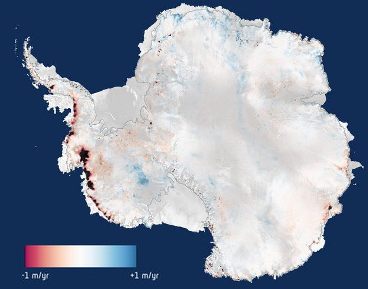 Rate of Antarctic ice volume change
Rate of Antarctic ice volume change
2010-2013. .
.
 Cryosat 2 remote-sensing ice.
Cryosat 2 remote-sensing ice.
ESA pictures on this page © European
Space Agency and used here (above and
below) under limited, non-commercial,
fair use. .
.
.
 Cryosat has a polar orbit and so covers all
Cryosat has a polar orbit and so covers all
of both hemispheres as the Earth rotates
beneath it. (Don't forget the other
hemisphere to Antarctica's.) |
Summer 2014 Climate change induced sea-level rise from Antarctica needs to be revised upwards. Which reminds me that back in July 1998 I was tut-tutted by a small workshop assembled by the Thames Barrier to discuss likely future sea-rise and the need for a successor Thames Barrier. However my comments were supported by just one individual, a former Government Chief Scientific Advisor: the one who advised former Prime Minister Harold Wilson to construct the barrier (National Archives ref: CAB 168/259). Back to today. Three separate pieces of research were announced in May. Rignot, Irvine and colleagues used satellite radar to measure the retreat of five West Antarctica glaciers and found that there is nothing to hold them back from catastrophic collapse. When this happens (and it could take many years) there would be enough melt released to raise the global sea-level by 1.2 metres. Separately Ian Joughin and his team modelled one of the glaciers (Thwaites) concluding that it alone could in a century add 2.5 cm to sea-level. Finally, data from ESA's Cryosat 2 satellite reveals that Antarctica is now losing about 160 billion tonnes of ice a year to the ocean: twice as much as when the continent was last surveyed in 2010. This research is led by Malcolm McMillan from the NERC Centre for Polar Observation and Modelling at Leeds University, UK.(See Geophys. Research Letters; Science vol. 344, p735-738; and ESA's Cryosat web page.) Back in 1990 the UN's Intergovernmental Panel on Climate Change (IPCC) worst case for sea level rise to 2100 was 110cm. Since then it has reduced its worst-case scenario to 88cm (2001) and 51cm (2007). The 5th IPCC Assessment (AR5), preliminarily published 2013, went the other way increasing rise estimates giving a worst case estimate of 81cm by the last decade of the 21st century. Now, with these latest results, it seems as if already this may be too low. (Though it should be noted that the IPCC sea-level rise estimates' small print do specifically exclude long-term warming feedback effects (dynamic response and catastrophic collapse).) So what happened back in 1998? Well each of us was asked to give a small presentation. Some were economic experts extolling the need to protect the City of London's economic wealth generation, others were into climate change: all had great faith in the IPCC's 1990 and 1995 assessments and its computer-model-based forecasts. Conversely, I had read the small print (saw the caveats) and drew upon palaeo-climate data to part underpin my hypothetico-deduction and suggested that we might consider preparing for a 2 metre rise per century rather than the IPCC 1990 worst case 1.1 metres. That I departed from the IPCC consensus view caused the tut-tutting from the assembled, all save from Solly Zuckerman. He was the Government's first Chief Scientific Advisor (1964-'71). Solly commented that it was refreshing to see someone there not taking models for granted and drawing upon actual data. Jump back to today and, notwithstanding this latest news from Antarctica, recent years have already seen increased concerns over ice melt in both hemispheres. Now that so many years have passed I am happy to share with you my 1998 Thames Barrier handout musings: I am surprisingly happy with it today, and would only slightly tweak it in the light of over a decade and a half's worth of subsequent science (and incidentally it includes a comment relevant to this year's rain-induced flooding). (I wonder whether future years will see IPCC 21st century sea-level rise estimates move even closer to my 1998 precautionary, 2 metre worst-case estimate?)
STOP PRESS 20th August. ESA's Cryosat 2 shows that both Antarctica and Greenland ice melt has doubled since mid-2000s. The research from Germany's Alfred Wegener Institute is published in The Cryosphere journal and suggests that both icesheets are contributing around 500 km3 of ice in the oceans annually. Also see http://www.bbc.co.uk/news/science-environment-28852980.
|
|
|
Summer 2014 House of Commons Select Committee report on Government Horizon Scanning has been published. As noted previously below, last autumn I submitted written evidence to the Science & Technology Committee and was then summoned to give oral evidence. The report has now been published. Its conclusion is that Government tends to use horizon scanning to support its own position (as an echo chamber) and not an attempt to systematically imagine the future in order to better plan a response. It also noted that the Government has a good horizon scanning resource in the Foresight programme but that the non-central location of the Government Office for Science (GO-Science (which was formerly the Office of Science & Technology)) means that it does not have the status it deserves.
Both Concatenation Science Communication and myself are mentioned in the main report. The thrust of my evidence -- that learned societies are well placed to inform as well as on occasion undertake horizon scanning -- was accepted by the Committee. I also understand that it helped frame some of the thinking of a parallel Select enquiry into antibiotic resistance; bangs for bucks etc.
|
|
.
.
.
.
.
.
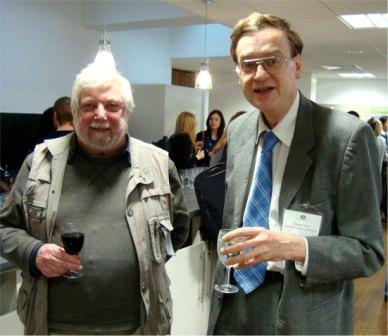 David Shirley and Jonathan
David Shirley and Jonathan |
Summer 2014 Inaugural meeting of the British Ecological Society's Climate Change Special Interest Group (SIG). As a longstanding BES member the creation of this group was particularly welcome. The meeting was well attended: a few score, possibly approaching a three-figure number attended, which was just enough to fill the BES lecture theatre at Charles Darwin House.
The morning saw a speed summary of the recent UN Intergovernmental Panel on Climate Change (IPCC) Assessment Report 5 (AR5) racing through all three Working Group reports (WG I, II & III). It is probably fair to say that the broad feeling of those attending (certainly those speaking) were in agreement with AR5's conclusions. Having said that, there were a number of concerns flagged including: the AR5 presentation style (in places confusing), IPCC author selection (it is a UN body and so member nation representation seems to count almost as much as the science expertise), and other non-science distractions (for example, the Bolivia's representative seemingly manadate to promulgate its
'mother Earth' initiative). And then there were the issues missed (my personal concern being the lack of developing the Initial Eocene Thermal Maximum (IETM), or Palaeocene Eocene Thermal Maximum (PETM), narrative from AR4, but I only discussed that with a couple over coffee and not in the main meeting). Climate thresholds were an IPCC AR5 omission noted: though a couple of years ago the IPCC AR5 agenda briefing did include this but it somehow got dropped along the way. The SIG end-of-session panel had mixed feelings about thresholds: the spring floods in Britain were cited as an example, but another panellist noted that some of the literature on thresholds (or 'tipping points' to use a terrible term) stretched the science. (Which to my mind is exactly why the IPCC should have teased out the literature).
I did note the IPCC changing base-year and base temperature problem and one of the panellists did refer to this concern during the end-of-day discussion.
The afternoon saw a review of some of the ecological issues including phenology and species tracking. (My concern for developing species translocation protocols did not come up other than the reiteration by a panellist of AR5's comment that it was controversial: I was not going to press the matter, nor did I introduce the related one of formal communication along climate-induced biome shift paths -- including across national borders -- as the day was already full and the issue too complex to address briefly (and besides I am pushing that agenda in a few other places).) Some research subsequent to the AR5 science cut-off was aired, including the impact of regionally differing rates of climate change and species tracking. The problem of attribution was also mentioned: how much of recent ecological degradation is due to climate change and how much to other factors such as development, agricultural nitrogen deposition etc.
|
|
And then there were people present. It was a pleasure to see someone whose work I have read for the best part of a couple of decades (and who had a few years ago coincidentally been kind about one of my own efforts). It also transpired that an old colleague, David Shirley, was attending (see above left picture). Back in 1994 David and I worked on a joint Institute of Biology, British Ecological Society venture with the BBC: a competition for the best school ecology experiment, and this formed the basis for a half-hour television programme. David and I also have a shared history in that we both spent postgraduate time with Prof Mike Pugh Thomas' and Dr Rev Stan Frost's Environmental Resource Unit at Salford U: David was there a few years earlier than I, but we both kept in touch with the Unit up until it closed (rather was merged with Salford's Environmental Science Department when Mike and Stan retired). Such fortuitous reunions are always welcome.
And the day's take-home message? Well the direction of emissions is taking us to the high-end of the IPCC business-as-usual scenarions (4°-5°C warming by the end of the 21st century) yet policy is that we can keep below 2°C -- hence we are planning for 2°C impacts. In other words we are currently aiming for 4°C but planning for 2°C; we should instead be aiming for 2°C and planning for 4°C.
As to the future, it will be interesting to see how the new BES SIG develops. (Hopefully we will see some palaeo-ecologists at future gatherings? We know a lot about past ecological change associated with both past warming and cooling: it's a tad myopic not to draw on that knowledge base when considering present-day change; the present is only a snapshot of an on-going, dynamic story.)
|
 Holding a piece of Mars...
Holding a piece of Mars...
(along with a piece of France). |
Spring 2014 Unlocking the Secrets of the Red Planet made for a great evening off and the chance to get up close with a piece of the 'Red Planet' Mars. (H. G. Wells eat your heart out.) The evening came courtesy of the Petroleum Exploration Society of Great Britain. This may seem an odd body for someone, who has spent some time in recent years examining the consequences of injecting fossil carbon into the atmosphere, with which to engage. Actually I do listen to the fossil carbon industry: one needs to so as to get as complete a picture of the issue. However in this instance they also organise the annual Stoneley Lecture (after the geologist Robert Stoneley) which itself is an exercise in science communication that aims to advance public understanding and debate.
This year's lecture was given by the science broadcaster Dallas Campbell (with support from aerospace engineer Paul Meecham and a meteorite curator from the Natural History Museum (Kensington). Hence the opportunity during the post-lecture reception to have a close encounter with a meteorite from Mars contained in transparent plastic. Dallas, it transpired in the lecture and subsequently in chat, had a mentor in late great
Ken Campbell whose company, with Concatenation colleague
Graham, I had the pleasure one long night at the 1979 Worldcon and then again more briefly years later during the intermission of a performance of Brian Aldiss' SF Blues. (They say that everyone is connected through half a dozen or so intermediaries.) Anyway, this is as close as I will probably get to the Red Planet just as examining microscope slides of lunar rock was regarding my proximity to the Moon back in my undergraduate days.
|
 IPCC AR5 WGI SPM (2013/4) temperature
IPCC AR5 WGI SPM (2013/4) temperature
projections (initital public release
subject to final copy edit).
IPCC figures on this page © IPCC
used here under limited, non-commercial, fair use.
Note, the base year above is 2005
whereas below it is 2000, and also the
0°C change also alters (see text below).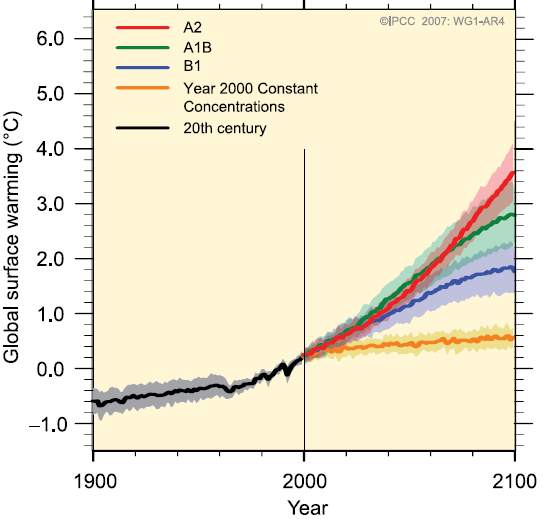 IPCC AR4 WGI SPM (2007)
IPCC AR4 WGI SPM (2007)
temperature projections. |
Spring 2014 IPPC -- The last of the three Working Groups of the Intergovernmental Panel on Climate Change (IPCC) has been published. Now, there has been much coverage elsewhere, but I take this opportunity to answer for you an IPCC question I suspect you did not know you wanted answered. It is this: how does the IPCC's 2014 Assessment Report 5 (AR5) temperature projections to the end of the 21st century compare to that of the IPCC's 2007 Assessment Report 4 (AR4)? This is a question that nobody in any of the coverage, from the high-impact journals, through the BBC and down to the gutter press, seems to have asked. So let me answer it for you now, because hereby hangs a science communication tale of some consequence. You see like many (but unlike some) I am a simple soul and a simple scientist. I really do like to compare like with like. Now, I hope that you are with me so far because from here on in it gets a little complicated.
Naturally, one expects projections of the potential climate future to change and, hopefully, improve with more data and a greater understanding of the Earth system with both leading to better models. This is fine: have one thing that changes and keep everything else the same for comparison purposes. But the IPCC does not keep things so simple. The bottom line is this, each of the five IPCC Assessments to date have used a different set of boundary conditions for their end-of-21st century projections: sometimes it is the base year that changes, sometimes the base reference temperature, and sometimes both.
|
|
|
For example, its AR4 (2007) 21st century projections had a base year of 2000 from which its projections ran and a base temperature 'relative to the 1980–1999 mean' from which they projected surface warming through to 2100.
Conversely, AR5's projections run from 2005 and have a base temperature of warming relative to 1986-2005 mean! All of which makes it a tad difficult to make comparisons between the two sets of projections. For your benefit both graphs are above left.
The AR5 projection of interest is RCP8.5, which is broadly analogous to what the IPCC called 'business-as-usual', or B-a-U, back with its first assessment in 1990 when life was so much simpler. (RCP stands for 'Representative Concentration Pathway'.) The AR4 projection of
B-a-U interest is the 'A2 scenario' (see page 749 IPCC AR4 WGI Physical Science Basis (2007) and p14 Fig SPM.5 of same). And the difference between the two? Well, once you have done all the conversions (and here I have done the heavy work for you) the difference is less than 0.1°C for the adjusted high estimate. Again, using a base year of 1990 (the year Kyoto work to and the 'effective' base year for AR4), the AR5 RCP8.5 high estimate for B-a-U warming for the year 2100 is close to 5.5°C. The AR5 RCP8.5 (1990 base adjusted) low estimate is 2.9°C (close to 0.9°C above AR4's A2 scenario low estimate). The adjusted AR5 RCP8.5 mid-estimate is 4.3 °C (also close to 0.9°C above AR4's A2 scenario mid-estimate). Why the IPCC are reluctant to communicate the increasing coherence of their high-end projections across Assessments (or that their low- and mid-estimates are getting closer to the high-end) is a bit of a mystery. (Do they really need to draw such a clear line between Assessments?) However if the IPCC carries on altering their base temperatures and years then B-a-U warming projections with successive Assessments in the future will reduce as we approach the century's end as the earlier 21st century warming is assimilated into successive Assessments' base temperatures: so not all the 21st century warming will be captured. And that will certainly send the wrong message!
|
|
.
Spring 2014 IPPC -- The second of the three Working Groups of the Intergovernmental Panel on Climate Change (IPCC) has been published. It is the one that looks at the impacts of climate change. And here they note that anticipated climate change under business-as-usual is likely to be greater than that that to which some species can adapt in terms of their migrating to cooler climate regions. Now, those of you who have been following my recent interests will recall that I have raised the concern that we need to start to seriously think about relocating species in the face of climate change (see second half of appendix 4 in the new substantially expanded (2013) edition of Climate Change: Biological and Human Aspects). I have also been raising this question in talks as well as with a number of bioscience, not to mention policy, stakeholders. But while so far there has been some welcome interest, there has been reluctance for anyone to take the lead: broadly the policy people do not want to unless the issue is raised by the scientists, and the state-funded scientists (because species translocation is ecologically controversial) do not want to unless encouraged by their ultimate political paymasters. (I did say in appendix 4 that this matter will "extremely challenging for my ecologist colleagues".) The question is whether this will change now that the IPCC has flagged up the problem that some species will face being outpaced by warming?
The IPCC's Assessment Report 5 (AR5) Working Group II (WGII) report makes it plain that some species will not be able to migrate as fast as climate zones shift with warming. This particularly relates to species in flat areas (species in mountain areas need only travel a shorter horizontal distance to reach cooler climate regimens at a higher altitude). WGII's report's Chapter 4 (section 4.4.2.4) says it all. "There is medium agreement that the practice of assisted migration of targeted species is a useful adaptation option". And, "some ecologists believe that careful selection of species to be
moved would minimize the risk of undesirable impacts on existing communities or ecosystem function, but others argue that the history of intentional species introductions shows that the outcomes are unpredictable and in many cases have had disastrous impacts". It also notes that "decisions regarding which species should be translocated are complex and debatable, given variability among and within species and the ethical issues involved". Nonetheless, I contend just because decisions are 'complex' and 'debatable' does not mean we should shy away from them. In fact it is because they genuinely are 'complex' and 'debatable' that we should bring expertise to bear on the problem. I hope that it is not too long before my second-half-of-appendix 4 call gets answered.
The IPCC's Assessment Report 5 (AR5) Working Group II (WGII) Summary for Policy Makers figure SPM.5 illustrates the problem (see below). It depicts the likelihood of trees being unable to cope with the rate of change assuming average global height variations as well as flat areas under the business-as-usual (B-a-U) RCP8.5 scenario, and that many herbaceous plant species in flat areas will not be able to cope. I should point out that the IPCC AR5 WGII makes this case without drawing upon the longer-term carbon feedback (carbon isotope excursion) concerns raised in our 2010 symposium. Take those into account and our reluctance to engage with the question of managing the change of biomes from where they are today to that of a globally-warmed world becomes one of positive dithering.
 IPCC AR5 WGII SPM (2014) Speed at which species can move compared
IPCC AR5 WGII SPM (2014) Speed at which species can move compared
to the movement of climate zones.
IPCC figures on this page © IPCC. |
|
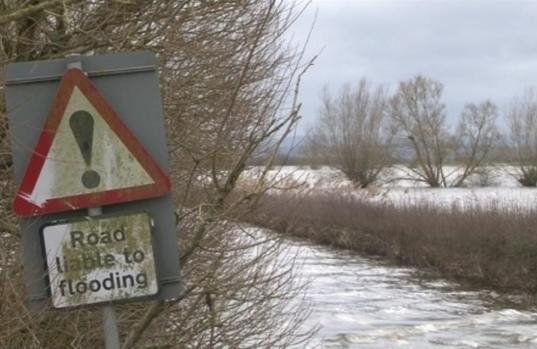 The Somerset Levels February 2014
The Somerset Levels February 2014 .
.
.
.
 Sea storm surge Newlyn, Cornwall Sea storm surge Newlyn, Cornwall .
.
.
.
|
.
Spring 2014 Persistent rain and a storm-driven sea surge causes much flooding. December (2013) had already seen storms and sea surges, so the ground was soaked and the water table high. Continued rain in January and February together with a track of storms -- driven by an uncommonly southern jet stream -- caused the flooding of many homes in low-lying areas (especially in the Somerset Levels and along the Thames west of London) and breached sea defences including that protecting the only rail connection linking Cornwall to the rest of Britain.
Back in 1997 I reported in Climate and Human Change: Disaster or Opportunity (p79) that the NERC's Institute for Terrestrial Ecology (now the Centre for Ecology and Hydrology (CEH)) that the capital cost of adapting UK coastal defences to the IPCC 1990 Business-as-Usual scenario for the end of the 21st century was £5 billion in 1985 prices, and that in 1987 the US Congress was told that the figure for their nation was of the order of US$100 billion (Smith & Tirpack The Potential Effects of Global Climate Change in the US, 1988): this last, of course, being pre-Katrina.
I have covered both sea level rise, extreme weather events and flooding in my books. (One excerpt from my 2007 edition of Climate Change on floods is here.) I have also noted that it is impossible to attribute a single extreme weather event (or even a season of extremes) to climate change but increasingly common extremes are precisely what we would expect with climate change: though attribution can only be obtained with hindsight by comparing the frequency (and even intensity) of events in one decade with those in the many decades before that. This is all covered in the 2013 edition of Climate Change: you might also check out the IPCC's 2012 SREX report on extreme events. Now (February 2014) Britain's Met Office with the CEH has produced a report (The Recent Storms and Floods in the UK) that chimes with the view I have previously given, saying: "there is now some emerging evidence that, over the UK, daily heavy rain events may be more frequent. What in the 1960s and 1970s might have been a 1 in 125 day event is now more likely to be a 1 in 85 day event. This supports other evidence that UK rainfall is increasing in intensity. This increase in the frequency/intensity of extreme daily rainfall events, as the planet warms and the atmosphere can hold more water, has been discussed in the literature for a number of years, and robust evidence for this is increasingly seen around the world."
|
|
|
Clearly these are difficult times – given the lack of US and European political diligence in controlling both finances, their respctive financial sectors, and the resulting current economic recession and debt – so spending on what is often perceived as the long-term problem of climate change is not high on short-term political agendas (irrespective of where along the political divide you might side). With regards to Britain, despite some protestations that building on floodplains has ceased, I find this hard to believe especially if you define a floodplain by its (now misnomer termed) thousand-year flood limit. (And the related issue of monitoring of constructors' strict adherence to the new energy building standards might be farcical were it not so serious.) As to what the electorate caught in all this can do? Well, ensuring that they have all the climate and climate impact facts at hand, with which to level-headedly challenge and/or encourage as appropriate their elected policy-makers, is essentially key.
 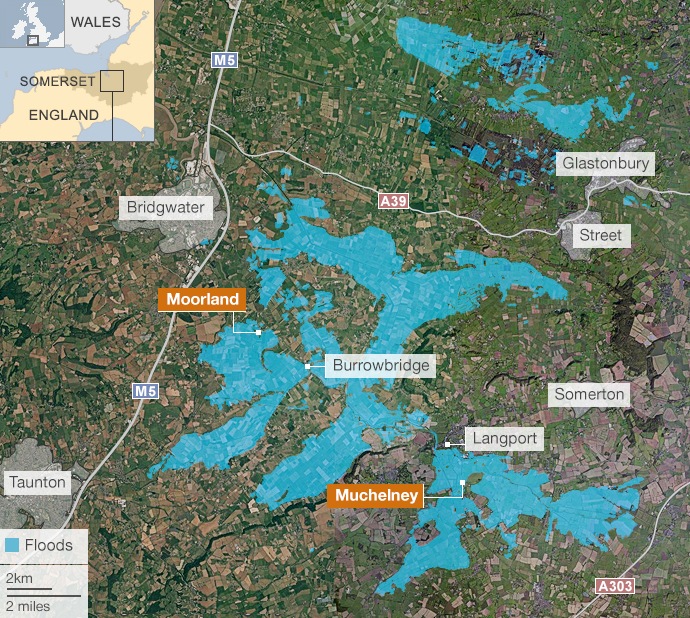 |
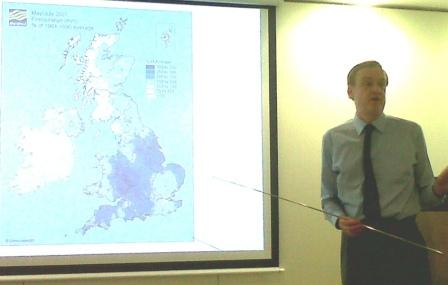 A lecture to the Society of Biology's
A lecture to the Society of Biology's
London Branch.
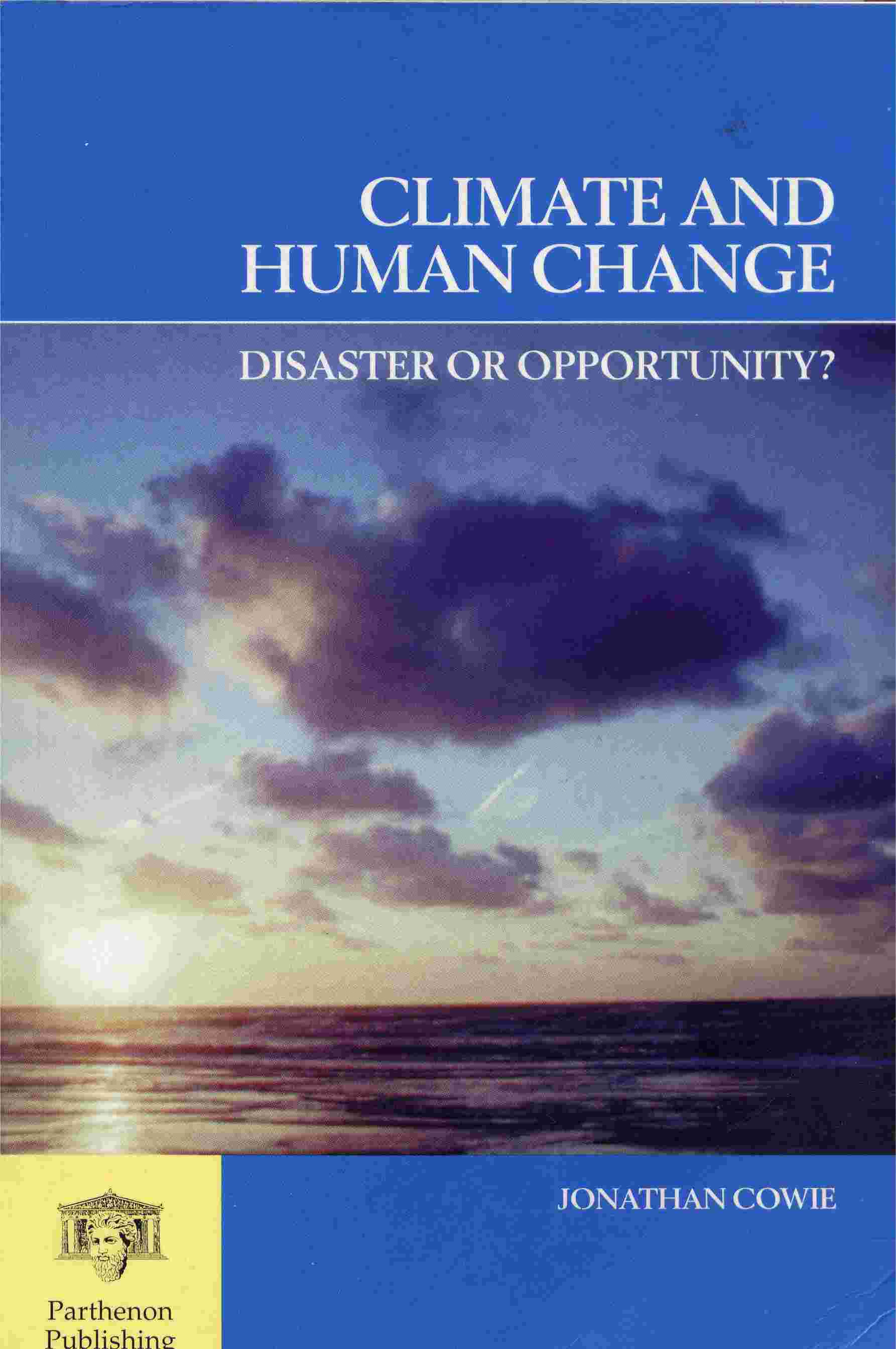 13 years to the day addressing the
13 years to the day addressing the
London Branch on a topic from the
1998 book (above) it was a return visit to discuss contemporary concens raised
in the latest title (below).
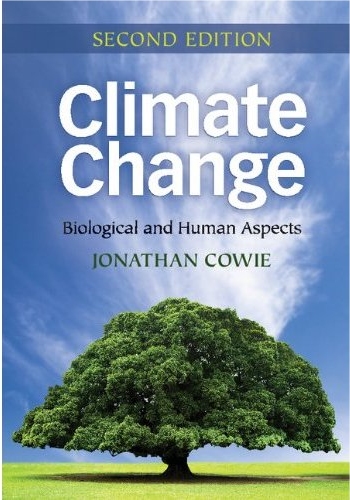
.
.
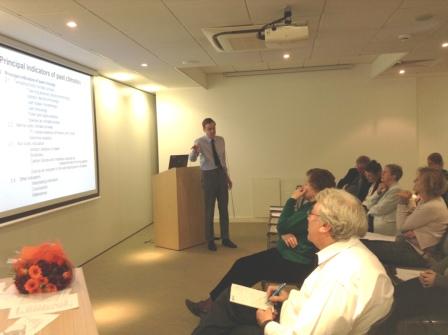
.
.
|
Autumn 2013 A lecture given at the London Branch of the Society of Biology on the new edition of Climate Change: Biological and Human Aspects (2013). Now it is not worth posting news of all talks/lectures, but this one was notable for a number of reasons. First, the Society of Biology (SoB) is the new re-branded Institute of Biology (IoB): the change happened some years after I left the IoB. The SoB today is very different from the former IoB (today it is more focussed on accrediting courses and reacting to science policy issues of the day, plus with its new, dedicated Parliamentary Officer holds more Westminster receptions than I ever could, but is less policy proactive and no longer does the range of book publishing the IoB undertook). This is not a criticism, biologists above all are aware of evolution and, irrespective of changes, it was good to see biology's professional body in its new home as a tenant of the British Ecological Society of which, as it happens, I am also a long-standing member. It was also a positive pleasure to see some of the old IoB London Branch members still in the saddle: the branches do great work waving biology's flag locally all over the nation. Secondly, the talk was an opportunity to air concerns as to the possibility of flipping into a new climate state analogous to the IETM / PETM (Initial Eocene Thermal Maximum / Palaeocene-Eocene Thermal Maximum) and need to at least consider the need to manage species translocation (which would happen irrespective of a climate flip. The former concern I covered in the first (2007) edition and the latter concern I raised in the second half of appendix 4 in the new substantially expanded (2013) edition of Climate Change: Biological and Human Aspects. With, for example, trees taking a couple of decades to get to a decent size, and further decades required to establish a woodland community, and with much of the land between national nature reserves broken up with agricultural systems and urban areas, some species arguably require a helping hand if their ranges alter due to climate change. Indeed, the pace of global warming is now faster than a number of species can adapt and we are already beginning to see some species in some locations being stressed. Yet, surprisingly, we do not have any established protocols for climate-change-driven species translocation (the closest we have are some worthy, but now dated, IUCN guidelines that relate to biological conservation). Climate-change-driven species translocation is needed for ecosystem function and carbon management reasons in addition to species conservation. Arguably, I contend, we need formal protocols as well as translocation communication between the network of existing principal nature reserve managers. One thing we know for sure, climate change is not going to go away. If we, the biological community, do not at least start discussing this issue then other stakeholders (such as land owners in and around nature reserves) are going to proceed to have their say without us when this issue does eventually climb the political agenda. Finally, as was pointed out by one of the SoB London Branch's senior members, my talk was given exactly 13 years to the very day of one I gave back in 2000 on a topic taken from my 1998 book Climate and Human Change: Disaster or Opportunity? Quite a coincidence! Of course back then I had a different focus. Folk tend to forget that back in the 1990s climate scepticism, as it is known today, was far more prevalent. Climate and Human Change: Disaster or Opportunity? summarised the climate and energy issue, the biology and human ecology, as well as perceptions. However it underlined the point that even if climate impacts were not severe (as sceptics believe), greenhouse policies are still exactly the ones we need to wean ourselves off of dwindling finite cheap fossil fuel before prices rose and to increase energy security and economic performance. Come to think of it, perhaps that message is still relevant over a decade and a half on? Perhaps it was surprisingly prescient: it was even written before the (UK Treasury commissioned) 'Stern report' in 2006... Anyway, besides the November talk being 13 years to the day since my 2000 presentation to the London branch, it also meant I have now given a talk to the Branch in each of the IoB's / SoB's homes: its own residences in Kensington SW7, then again off of Fleet Street EC4, and now finally its current adopted home at the British Ecological Society's Charles Darwin House. The post-lecture buffet was distinctly better than back in my IoB days. There were a few older biologists interested in the cross-disciplinary (physical geography, geology and biology or 'Earth systems science') approach and some young students asking very sensible questions. A good time was had by all.
|
|
|
Autumn 2013 and NASA have given us a new 'pale blue dot' (see above photo) that so successfully demonstrates our tiny, fragile place in the cosmos, that we are actually invisible! Some of you may have missed this November 2013 news courtesy of the NASA half of the NASA-ESA Cassini-Huygens mission to Saturn and its moons.
|
|
|
|
Meanwhile hark back to Carl Sagan and his description of Earth in 1990 as a 'pale blue dot' due to a picture taken from far out in space by the Voyager craft. Could we take such a shot again? Certainly! However the best pictures long-distance pictures of Earth (Terra) are taken when -- looking back to the heart of Sol's system -- the glare of the Sun (Sol) is masked by an eclipse. So July this year NASA's Cassini probe took a sequence of 19 pictures from the far side of Saturn, eclipsing the Sun, looking back to the centre of the Solar system to give us an almost Stanley (2001: A Space Odyssey) Kubrickian view of the core planets of Mars, Venus and our Earth. These photos were assembled to form a single picture and in November this was released to the media (but only a few covered it). We are so small that our Earth does not show up on the larger mosaic picture above. But the smaller picture has small blow-ups showing where we can be found. The Earth's biosphere systems may seem large, and to us hard to perturb causing things like climate change and ocean acidification, but this stunning view by Cassini does put us and our world into fragile perspective... I simply had to ensure you shared in this sight.
|
|
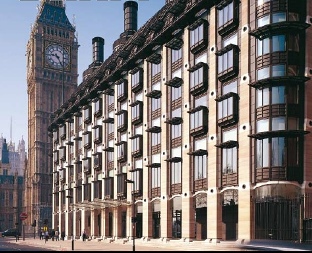 The Palace of Westminster's Portcullis House: venue for the Select Committee's evidence session.
The Palace of Westminster's Portcullis House: venue for the Select Committee's evidence session. 'Horizon scanning': the process by which long-term issues of concern are identified with a view to addressing in the short-term.
'Horizon scanning': the process by which long-term issues of concern are identified with a view to addressing in the short-term.
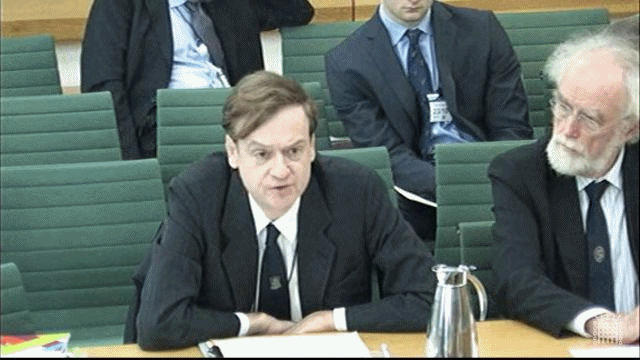
Giving evidence to the British Parliament's House of Commons Science & Technology Select Committee |
.
Autumn 2013 and a summons to the House of Commons Select Committee for Science & Technology. An unusual experience for myself. Normally my role is one of secretariat-plus-collator of the views of experts on behalf of learned bodies, knocking them into some sort of coherent and relevant shape, and then submitting the resulting written evidence. If further oral evidence is requested to provide detail on some specialist aspect, then normally I nominate an expert to provide this. However, this occasion was rather different. The Select Committee's inquiry topic was 'horizon scanning'.
Now, I have been trying to cut back Parliamentary activities so that the proportion of precious time I have that I can devote to science be more focussed on writing and scholarship activities (engaging with learned societies, reading, attending symposia etc), and I had thought that the British Ecological Society reception in the summer would have drawn a line underneath my Parliamentary engagement career such as it has been. However the Committee's enquiry on 'horizon scanning' was something related to a good number of projects I have undertaken (and/or participated in) over the decades. 'Horizon scanning' is the process by which we look up from our day-to-day mundane concerns and look into the medium-to-long term at issues not yet firmly on the policy radar to warrant action as it may be that such issues coming over the horizon (metaphorically speaking) will warrant attention now so as to avert socio-economic (hence political) cost later. Because I am at the tail-end of my career I do have the benefit of past experience as to what we did think on some issues in the past and how others then reacted compared to how we think of the same issues today with the benefit of hindsight. As such I was called in to give evidence in my capacity as former Head of Science Policy and Books at the Institute of Biology (with emphasis on the 'former' and the learned and professional body the IoB, so as not to tread on the toes of the good folk at the subsequently re-branded and less learned society / more professional biology Society of Biology (SoB)). The two examples I gave related to antibiotic resistance and biofuels though I did manage to give a plug for one of my current (forthcoming) concerns as to the need for nature reserves to manage climate-induced, species' range migration along climate gradients at the national-to-international scale or species translocation. (This issue I raised in the second half of Appendix 4 of Climate Change: Biological and Human Aspects.)
For those of you unfamiliar with the science policy-maker scene, Select Committees are all-party committees. House of Lords Select Committees relate to topics generally and how they in turn relate to society. Conversely, House of Commons Select Committees have the specific task of determining the efficacy of Government Departments (Ministries) and their agencies in addressing these issues. There are two 'Science & Technology Select Committees, one for each House. The Government has to respond to the outcomes of any Commons Select Committee inquiry and respond to any further questions and conclusions. Oral evidence to Select Committees is transcribed and (unless the topic relates to matters of national security) members of the press and public are allowed to attend (space permitting), and these days the event is broadcast via the internet.
|
|
|
 2013 Delta Award judges: Jim Walker, Jonathan C., & George Houston
2013 Delta Award judges: Jim Walker, Jonathan C., & George Houston
|
Autumn 2013 Roped in as a Delta Award judge. September and it was the Festival of Fantastic Films for the second year in a row.
Normally I only go to the Fest once every two or three years but as 2014's long-term commitment diary is already looking full, and as I already had another engagement in Manchester that week, the Fest was tempting (especially as it was founded, way back in 1990, by an old friend, the late Harry Nadler). One
of the Fest's regular happenings is the Delta Award for amateur science fiction/fantasy/horror (SF/F/H) short films. For some reason, this year I got roped in as a judge. Along with me were my civil engineering (water) friend Jim Walker and horror aficionado George Houston.
It is an international competition and if you can (and if you are an SF/F/H enthusiast), I recommend you check out the tying winning entry from France Mecs Meufs [Boys Girls]. It is a comment on gender roles. It has excellent production values and even seamlessly manages to include a brief song-and-dance number. Brilliant.
|
 INTECOL 2013
INTECOL 2013
The International Ecology Congress
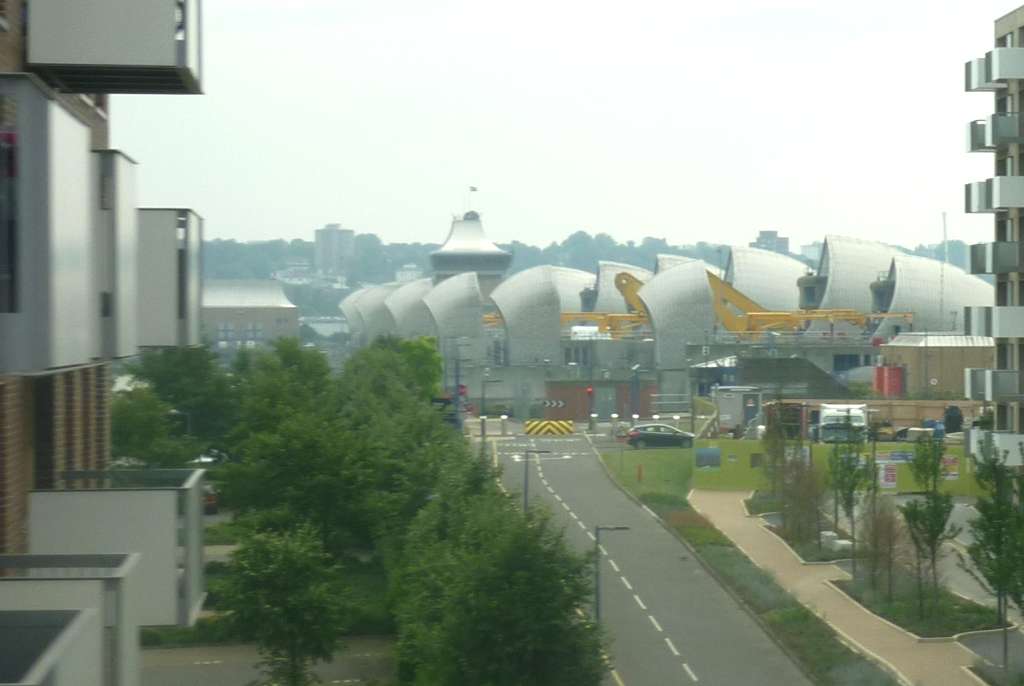 INTECOL was held just downstream of the
INTECOL was held just downstream of the
Thames barrier. (More Thames Barrier
related tidbits summer 2014.)
 Presenting a poster on past abrupt climate and ecological change with regards to future change
Presenting a poster on past abrupt climate and ecological change with regards to future change
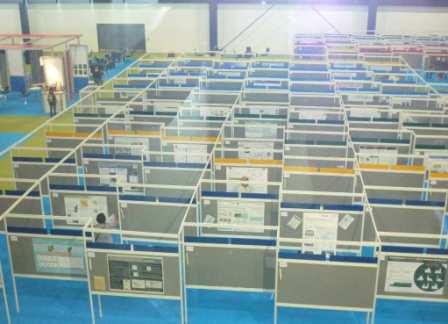 The poster part of the exhibits
The poster part of the exhibits
and poster hall.
|
Summer 2013 INTECOL -- The International Ecology Congress came to Britain. INTECOL is only held once every four years and in a different country; it is kind of like the ecological equivalent to the Olympics. The last time it was in Britain was in 1990 and I was that event's press liaison manager. This time I was attending as a normal bod, in part to promote the new edition of the book (as part of which I presented a science poster and Cambridge U. Press had a stand), and in part to try to galvanise discussion on the need to consider actively translocating species between nature reserves along climate gradients due to climate change for the inter-related purposes of biological conservation, maintaining ecosystem function, and minimising carbon loss. Some progress was made on all fronts.
It was held at the London ExCel and so I spent a week at what passes for Concatenation's London-area mission control as the commute from there to ExCel via London Dockland's was easy (the East Midlands too far). For those of you who do not know the new ExCel Exhibition and Conference Centres, they are in the old London docklands that have been re-developed as part of the 2012 Olympics. The area is still being re-developed and the new bits are all surprisingly low-lying with little (virtually no) storm surge protection: which I am not sure is particularly wise given it is the wrong side (just downstream) of the Thames Barrier.
There were very roughly a couple of thousand attending. It saw some very good morning plenary lectures and 15 or so breakout (parallel) programme streams. A busy time was had by all. However it was very main-stream ecology and there seemed to be little on the conference theme 'Into the next 100 years': a slogan that more reflected this year's hosting body's, the British Ecological Society's, 100th anniversary than any actual science theme. So there was no reaching out to other disciplines such as ecotoxicology: I particularly missed the palaeoecologists (there were only two papers on that) as well asthe Earth system scientists working on the recent 'co-evolution of life and planet' NERC programme. A number commented on this tight focus as being a missed opportunity. Having said that, while the main hall could easily hold another thousand, the breakout parallel session rooms were more or less full and probably could only accommodate another 500 or and even that would necessitate using the two unused breakout rooms: some of the more packed breakout sessions were a little (ahem) sweaty.
At the end of the day much ground was covered. 2017 sees INTECOL in China.
|
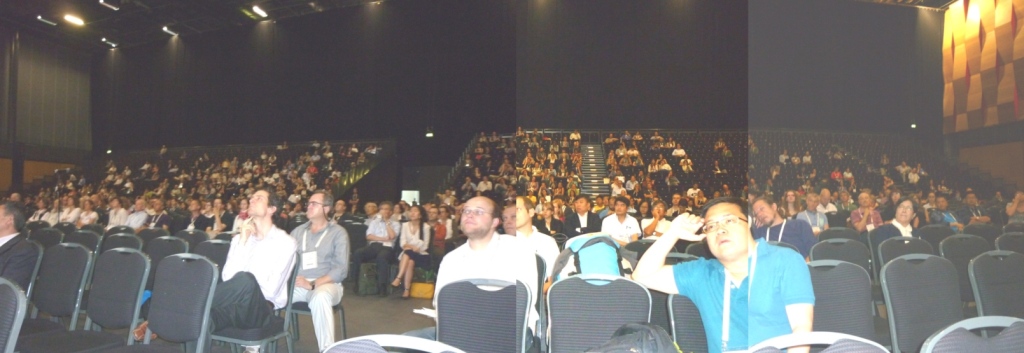 INTECOL main hall prior to a morning plenary session.
INTECOL main hall prior to a morning plenary session.
It could easily hold the event's couple of thousand participants.
 INTECOL exhibition hall: exhibitor stands far left, posters in centre / front
INTECOL exhibition hall: exhibitor stands far left, posters in centre / front
|
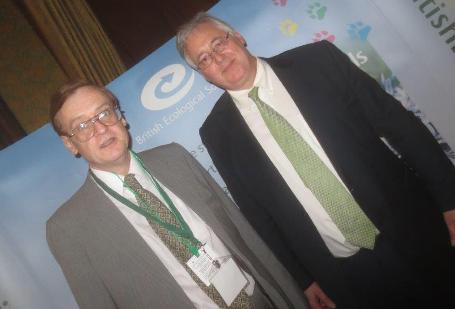 Blow us sideways, it's Jonathan and Stephen Benn (current biological societies Parliamentary Officer)
Blow us sideways, it's Jonathan and Stephen Benn (current biological societies Parliamentary Officer)
|
Summer 2013 Parliamentary launch of The Impact of Extreme Events on Freshwater Ecosystems. This publication is part of the British Ecological Society's (BES) 'Ecological Issues' series of briefings. It specifically looked at the ecological impact of extreme flood and drought events. Very useful and also at the Parliamentary launch was a superbly written concise summary sheet. (It was so good that it was positively a shame this could not have been included as a summary within the briefing document itself.) These briefings do not usually warrant a launch, let alone a Parliamentary one in the House of Commons, but as this year (2013) sees the British Ecological Society's 100th birthday, a few stops were pulled out. Having to be in London that day anyway, because the topic is one of interest to my climate change biology concerns, and due to longstanding BES involvement, I thought I would go if nothing else as one last Parliamentary social event as I am a couple of years from retirement and forthcoming projects will be taking me elsewhere. (As it turned out this was not to be as later in the autumn I was summoned to the Palace of Westminster (see above).)
The social aspect provided a serendipitous chance to meet old colleagues including Stephen Benn. Stephen used to be the Royal Society of Chemistry's (RSC) Parliamentary Liaison manager over a couple of decades when the RSC regularly engaged with Parliament and when I was science policying at the Institute of Biology: I was on Stephen's RSC Parliamentary Committee for over a decade up to 2006. A few years ago, when the RSC reorganised to focus on publishing, Stephen moved to work for a collective of biological societies under the auspices of the Society of Biology (the subsequently re-branded Institute of Biology). In short, Stephen and I share much intertwined history.
|
|
|
 Summer 2013 sees atmospheric carbon dioxide surpass the 400 ppm mark.
Summer 2013 sees atmospheric carbon dioxide surpass the 400 ppm mark.
Pre-industrial 17th century concentrations were around 280 ppm.Summer 2013 May sees the passing of a landmark: average atmospheric carbon dioxide rise will pass the 400 parts per million mark (ppm) at Mauna Loa, Hawaii. Due to the annual rise and fall of northern hemisphere CO2, as well as CO2 varies in different parts of the Earth (this measurment is part of the Keeling curve observed in Hawaii) it will be a couple of years before CO2 will remain over 400 ppm for over a year, but that will certainly happen. This is not a milestone to celebrate, but is one we might all do well to note. Many may think that they are aware of this event's significance; few truly are. The last time the Earth saw CO2 concentrations this high was over three million years ago and the Earth then was a different place with higher seas, more acidic oceans and, of course, far warmer with less Antarctic ice. The next arbitrary (afterall what is the significance of a round base ten number) milestone will arguably be 500 ppm and this will happen around the middle of this century and well within the lifetime of many alive today. If we carry on as we are (IPCC A2 scenario) according to the IPCC 2007 (see figure 10.20, p790 of the WG1 report) we will pass the 750 ppm mark a couple of decades before the end of this century, and the 1,000 ppm mark a couple of decades into the next century. The Earth will not have seen this level of atmospheric CO2 for 40 million years, long before human evolution let alone the rise of the Neogene and Quaternary assemblages of species among which humanity developed. But do not worry: it is not the end of the Earth's biosphere which has seen far worse insults over the eon. Of course, whether we can sustain the billions of humans this century anticipates, over this period of global change, is quite another question... So mark the 400 and keep counting. Stop Press: Global carbon dioxide concentrations reached a new monthly record of 400 parts per million as a global average in May 2015. The US National Oceanic and Atmospheric Administration (NOAA) collects its data on global carbon dioxide concentration on air samples taken from 40 sites around the world.
|
|
 Using SF imagery -- Star Wars: Empire Strikes Back logo -- at the Royal Society summer fayre to promulgate anti-infectives
Using SF imagery -- Star Wars: Empire Strikes Back logo -- at the Royal Society summer fayre to promulgate anti-infectives
.
.
 Car park kingdom for a zero-fossil-carbon, equine ungulate
Car park kingdom for a zero-fossil-carbon, equine ungulate
|
.
Spring 2013 It is always a pleasure to see SF imagery promulgate a science message. And so at this summer's Royal Society fayre (always worth a visit) we saw an exhibit captioned 'Virus Wars: Antibodies strike back' in the style of the Star Wars: The Empire Strikes Back logo. Other interesting displays including a 3-D cosmological film we both enjoyed and one on quantum entanglement: I am still betting on the feasibility of an ansible and the lead scientist was on hand and affirmed that my loopholes were genuine loopholes worthy of exploration... So here's hoping.
This year joining us were a few contributors to the Concatenation genre wing. As Concatenation's genre wing is run by a group of mainly scientists and engineers who live in different counties, indeed countries, it is very rare for more than a two or three of us to actually get together, so half-a-dozen was a little special.
Spring 2013 The occasional commute to London, and what passes for Concat's London area mission control, has been enlivened by Richard III. Since the discovery of Richard III's remains in a local car park, there has been a fair bit of media attention the past year and especially now that Richard's identity has been confirmed. And so a few times it has been possible to meet science media folk on the train. (One has to grab these networking opportunities.)
|
|
.
.
.
.
.
.
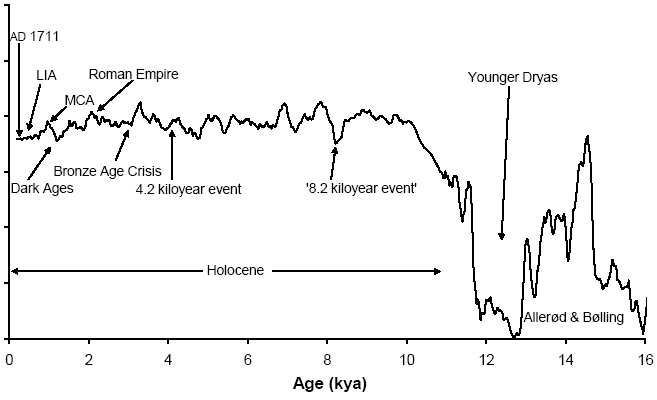 The Holocene is the current warm interglacial we are in within the Quaternary period. It has seen a 'comparatively' stable temperature for the past 10,000 years (10 ky) or so. The above thumbnail of N. hemisphere temperature is in the process of being revised with data from both hemispheres. It is due to be published in 2014/5 and is likely to show a slightly warmer Holocene maximum broadly around 5 - 9 ky ago This was one area of news from the Holocene symposium in the spring of 2013.
The Holocene is the current warm interglacial we are in within the Quaternary period. It has seen a 'comparatively' stable temperature for the past 10,000 years (10 ky) or so. The above thumbnail of N. hemisphere temperature is in the process of being revised with data from both hemispheres. It is due to be published in 2014/5 and is likely to show a slightly warmer Holocene maximum broadly around 5 - 9 ky ago This was one area of news from the Holocene symposium in the spring of 2013. .
.
.
.
.
.
.
.
.
.
 Snowball Earth II of the Neoproterozoic that took place before the Cambrian and the explosion of new animal species that was the focus of the Cambrian symposium.
Snowball Earth II of the Neoproterozoic that took place before the Cambrian and the explosion of new animal species that was the focus of the Cambrian symposium. .
.
.
.
.
|
|
Spring 2013 Fossil carbon leakage from the British economy is offsetting UK emission reductions says Britain's Committee on Climate Change. The news just out confirms that the reductions in British greenhouse emissions -- that this and the previous government enthused -- have been actually been offset by other countries' emissions used to produce Britain's imports. This economic carbon leakage (as distinct from the quite separate ecological carbon leakage) was a concern raised in Appendix 4 of the 2nd edition of Climate Change: Biological and Human Aspects. And just in case there is any question of timing, I finished writing Christmas 2011 with just tidying and only add the most significant of the very latest research to do. I submitted the manuscript to Cambridge U. Press in mid-March 2012. Then in April 2012 the House of Commons Energy and Climate Change Committee raised its own concerns. It looks like this issue is now beginning to be taken seriously and will run.
Spring 2013 Holocene two-day symposium attended. More continuing professional development (CPD) with a symposium on the Holocene: the past 11,700 years (11.7 ky) of which the past 10 ky has seen a comparatively stable temperature that coincides with human transition from the Stone Age to Bronze Age and ultimately to the Industrial Revolution and our present technological society. Understanding Holocene climate variability (which did not see significant human impact on the global climate) is important if we are to disentangle properly current human-induced warming from natural variability.
Spring 2013 Sir Nicholas Stern is the latest to warn that we will miss preventing the Earth warming by 2°C target. This concern has been growing for some time now; indeed, I addressed this issue back in August 2009. Sir Nicholas Stern was commissioned to write an independent report on the Economics of Climate Change in 2006 (published by CUP in 2007), now warns that: "the risks [are] of a four- or five-degree rise." This is the latest alert that we will exceed the 2°C limit of a number of warnings from 2010 onwards. Though my 2009 view is gaining traction -- that comes with a hint of personal intellectual satisfaction -- it is not something from which I derive great pleasure.
Spring 2013 Cambrian explosion two-day symposium attended. The Cambrian explosion saw a huge number of new multicelled animal species (metazoans). This was one of the key periods in the co-evolution of life and planet that directly followed Snowball Earth II ('Slushball' if you want). Understanding this is not only important regarding the evolution of life on this planet but arguably is potential relevance to the evolution of life on Earth-like exoplanets. How many with an interest in astrobiology present? Only a small handful of us. The rest were palaeogeoscientists together with a number of geochemists.
New Year 2013 Further considerations: climate science and policy beyond 2013. As promised, appendix 4 of the new edition is now on-line here: Further considerations: Climate science & policy beyond 2013. Its principal two key points for discussion are: i. the need for proper fossil carbon accounting by and between nations, and ii. the need for biome shift to be included in nature conservation management hence active species translocation.
New Year 2013 The 2013 edition of Climate Change: Biological and Human Aspects has formally come out from Cambridge U. Press (January 2013). The new edition has nearly a third more text and many more diagrams in addition to being completely updated. Consequently CUP have registered a new ISBN for the title: 978-1-107-60356-1. Orders can now be placed with Cambridge University Press depending in which country you live. See the Cambridge.org site:-
Great Britain & NI - £34.99
N. America - US$69.99
Australasia AUD$80.95
New Year 2013 And the first reaction to the new book has been rather kind. CUP started marketing the new edition back in the autumn and some advance copies were out in December prior to the book's January 2013 official launch. Just before Christmas (2012) Bioteaching.com cited Climate Change: Biological & Human Aspects as one of the Top Environmentalism and Climate Change Books of 2012 saying "Every year sees the release of an excellent academic text on climate change summarising all aspects of what we know. This is this year's version of that book, and it's a useful tome for anyone looking for the most current and up-to-date resource book on climate change." This in turn was picked up by ScienceBlogs.com Best Teaching Biology Science Books of 2012… and Christmas was not even 2013 and the book's formal publication!
[Past news 2011/12]
[Current news ]
[Bioscience interactions | Climate change interactions | Science & Fiction interactions | What is Concatenation all about? | Home ]
|
|
|




